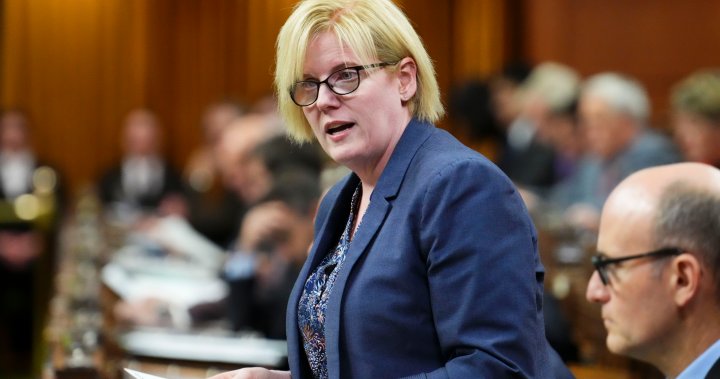
The Liberal government left employment insurance reform out of the federal budget this week over concern that reforming the program amid a slowing economy could drive up premiums for workers and employers.
That’s according to a spokesperson for Employment Minister Carla Qualtrough, who said the federal government “remains committed to modernizing the EI system.”
“However, the current and near-term economic context caution against measures that could put pressure on EI premiums and we needed to be careful about any decision that could make it harder for workers and employers to make ends meet,” the spokesperson said in an email.
After the last federal election, Prime Minister Justin Trudeau handed out a mandate letter that tasked Qualtrough with bringing forward and implementing a plan to “modernize the EI system for the 21st century” by summer 2022.
As the summer was ending, the minister promised reform was coming soon. “By the end of the year, you’ll know what the vision for EI is,” she said in September.
There was scant hope that, several months into 2023, the federal budget would finally hint at the government’s plans. Sure enough, its narrow focus on the clean economy and health care left other agenda items off the table.
The federal government, which is now expecting a mild recession this year, appears to be avoiding EI reform right now so as to not drive up the cost of the program. A recession would likely come with job losses. Expanding eligibility now could result in even more people tapping into the program.
There is a long list of complaints about the current structure of the program, on its eligibility requirements, financing and administrative technology. But the central concern for workers is that too few can access the program.
In 2021, the Liberals had campaigned on a promise to modernize EI and pledged to expand the program to cover self-employed workers and address gaps highlighted by the COVID-19 pandemic.
Finance Minister Chrystia Freeland signalled Thursday that broader reforms are still coming.
“My colleague Carla Qualtrough … is hard at work on broader EI improvements and that is important work that has to be done thoughtfully and carefully,” she told reporters in Surrey, B.C.
Freeland cited two changes to EI announced in the budget.
One measure proposes extending a temporary change to EI introduced in 2018 that increases the number of weeks of coverage available to seasonal workers. The other aims to strengthen prohibitions against employee misclassification for federally regulated gig workers.
The National Council of Unemployed Workers reacted to the budget by calling on the NDP to withdraw its support of the Liberal government through the parties’ supply-and-confidence agreement.
“We are fully disappointed, because the government is betraying its commitment and choosing once again the status quo,” Pierre Cere, a spokesperson for the group, said in a statement.
“In light of this situation, we are asking the NDP to withdraw its confidence in the government and for MPs to put their seats on the line over this issue.”
A member of the Canadian Employment Insurance Commission, which includes both labour and business voices and helps to oversee and review the EI system, added to the criticism.
As Ontario announces minimum wage increase, here’s how others compare
Woman who knew teen stabbed in Toronto subway found him injured, tried to save his life
Pierre Laliberte, its commissioner for workers, said it was “very disappointing” to see EI reform left out of the budget.
At the very minimum, the federal government could have included interim measures to address major gaps and expand access, he said. “It really is absolutely bizarre that the government would not have seen fit to at least … plug some holes here and there.”
During the pandemic, the government had expanded access to the EI system via temporary measures. Those expired in September, despite staunch opposition from labour groups and the NDP.
Under the temporary measures, workers qualified for EI based on a national requirement of having worked 420 insurable employment hours, whereas workers would normally need between 420 and 700 hours depending on the regional unemployment rate. And monies paid upon a worker’s separation from a job, such as severance, were not deducted from the benefits.
The lack of clarity on the future of EI reform comes as many economists anticipate the Canadian economy will enter a mild recession this year, which is expected to come with some job losses.
Canadian Labour Congress president Bea Bruske said implementing EI reform would help “recession-proof” the economy for workers by ensuring the social safety net can support those who face layoffs.
But Laliberte said EI reform doesn’t appear to be a priority for the Liberals or NDP. Both have been more focused on delivering a federal dental care plan, he said, despite health care being under provincial jurisdiction and the EI program being a federal responsibility.
“It’s not sexy,” Laliberte said of EI reform. “Announcing something new, like dental care _ it’s glamorous, right?”
In a statement, NDP deputy finance critic Peter Julian said New Democrats are proud of what they accomplished for Canadians in the budget, but they are “not satisfied.”
“It is shameful that the Liberals failed to include EI reform in the 2023 budget as economists are warning that we’re heading into a recession,” Julian said.
“New Democrats will continue to push the Liberals to reform EI and make sure no worker is left behind.”







